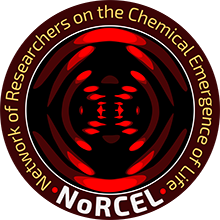Block title
NoRCEL’s Engagement in Africa: The AstroScience Exploration Network (ASEN)
Materializing on the vibrancy of the African continent, recognizing its people as a key asset, and building on specific strategic advantages, ASEN will funnel the appetite for scientific knowledge through an educational hub that paves the way for the Global South to come to the fore in new global endeavors and will eventually help build a variety of career paths in a diversifying economy.
Metabolic Intermolecular interactions in Bubble membranes
Molecular gene biology
Bob Bruner’s Meteorites and Minerals Exhibit
Here is the story:
It is commonly accepted that you need three conditions for life to start:
A source of Organic Molecules
A solvent (water )
A source of energy to power the start of life
Each of the minerals shown in this exhibit are hypothesised to comply with a certain context for the origin of life, i.e.:
Under water to protect from impacts on surface
On surface to get wet/dry cycles
Compartments on surface for organic molecules
Enough dry land to create boron to help RNA
Method to transfer Mars life to Earth
Method to...
The Gap Map and Grothendieck’s Rising Sea
Mathematician Alexander Grothendieck, whose work is considered abstract even by mathematical standards, once described two ways of solving problems. The first takes the idea of a problem being a tough nut to crack quite literally:
"…put the cutting edge of the chisel against the shell and strike hard. If needed, begin again at many different points until the shell cracks—and you are satisfied."
The second method is of a rather different character:
"The unknown thing to be known appeared to me as some stretch of earth or hard marl, resisting penetration. . . the sea advances insensibly in silence, nothing seems to...
Evolution of proteome based on the evolution of genetic code
The evolution of species by means of natural selection can be modelled in a "tree of life" (ToL) that can be traced backwards in time . At the root of the ToL is a hypothetical being known as the Last Universal Common Ancestor (LUCA) . LUCA is in turn the outcome of several evolutionary events distinguished by the primacy of various fundamental components: geochemical prebiotic molecules → nucleotides (nt) + amino acids (aa) → RNA + → + aa → + DNA → + RNA (cf. ).
The "RNA world" is the evolutionary stage where autocatalytic...
The asteroid belt
The asteroid belt, a region located between the orbits of Mars and Jupiter, is composed of millions of rocky objects ranging in size from tiny pebbles to large asteroids several hundred kilometres in diameter. These remnants from the early formation of the solar system provide valuable insights into the evolution of our cosmic neighbourhood.
As an aspiring astrophysicist and citizen scientist, I recently identified an asteroid that had never been seen before, using the Astrometrica software for analysis. This discovery, now named "DPR1729," underscores the significance of individual contributions to scientific research and validates my passion for exploring the cosmos....
What isn’t Life?
For centuries, mankind has struggled with the problem of defining life. Just what is it? What makes it different from things that are not living? It seems that the main difficulty is that we do not yet have a good enough model of what living is, in its widest sense to even start to provide definitions. To put this problem into perspective, there are two big scientific ideas that have helped humans to try to understand (at a crude level) how our Universe works; Einstein’s theory of general relativity and the concept of quantum mechanics. The former allows us...
Are We the First: Was There Life Before Our Solar System?
The enduring question is: “Are We the First?” From what we already know of chemistry—especially that of carbon and water—it is highly probable that we are not the first. We also may well not be alone, with even the possibility that life elsewhere in the Cosmos could be ubiquitous—and often, from time to time, scientists make bold, optimistic, conjectures about such life. To ascertain how any life emerged on Earth and, therefore, may have emerged elsewhere in the Universe is proving to be an uphill task. To put it in other words, we don’t even know how many relevant...
Searching for life on Venus
Venus is the closest planet to the Earth and the brightest celestial body after the Sun and the Moon...
NoRCEL Astroscience Exploration Network ASEN
The Astroscience Exploration Network (ASEN) is NoRCEL’s innovative initiative and has the objective of creating an African Astroscience Hub. This original concept aims to...
International Frontiers of Science Project (iFS)
The objective of the International Frontiers of Sciences (iFS) is to promote the latest discoveries in the field of the origin of life. In...


